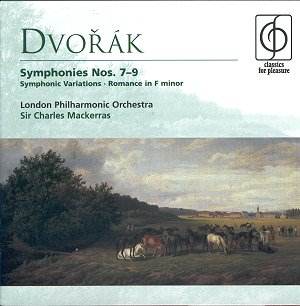Sir Charles Mackerras knows his Czech music; he was
responsible in large measure for bringing awareness in
this country of the wonders of JanŠčekís operas, and, in these
fine recordings, has brought the same flare and imagination to these
well-known and popular works by DvořŠk. In many ways, Mackerrasís
approach is, not surprisingly, similar to that he displayed in
his recently completed set of the Beethoven symphonies. He does everything
he can to let the music speak for itself with the minimum interpretative
intervention. Yet he relies on his musical instincts too, and moulds
the music in a personal and mostly very convincing way.
Excellent thought the results were from the RLPO in
the Beethoven series, he here has an orchestra, the London Philharmonic,
with a more integrated sound, richer strings, better internal balance.
The playing is in fact quite outstanding throughout the two CD set,
and the recordings have captured it faithfully.
Mackerrasís recordings of the seventh and eighth symphonies
were new to me, but this New World has long been one of my personal
favourites. Itís very interesting to compare it with the disappointingly
bland Previn/Los Angeles Symphony recording of this work which I reviewed
a little while back. The differences are evident from the very beginning
of the slow introduction. Mackerras, unlike Previn, achieves drama and
maximum contrast, drawing out pauses to allow the music to breathe and
emphasise the feeling of suspense and expectation. In the Allegro
(though itís a great pity he doesnít make the repeat), all the details
of scoring emerge cleanly, and the rhythmic drive is irresistible, leading
to a really thrilling climax in the coda.
The famous Largo receives a particularly poetic
performance, and the excellence of the playing as well as Mackerrasís
meticulous attention to detail is shown in such things as the balance
of the solemn trombone processional at (track 2)12:16, or the final
extraordinary chord for four solo double-basses, as perfectly tuned
and placed here as Iíve ever heard it.
Thereís no hint of anything routine about this performance,
and the excitement continues unabated from the Scherzo, played
with zest and energy, through to a really outstanding finale. How often
this movement can sound rather tired and unsatisfactory! None of that
here, for the music is, like the first movement, driven forward inexorably,
until the ultimate agonised counterpoint of the main themes of first
movement and finale achieves a monumental grandeur, surely what the
composer wished for (but very rarely gets!). Along the way, Mackerras
constantly allows us to relish details of the scoring, such as the little
semiquaver groups in violas then ícellos around (track 4) 6:19, or the
bassoon counter-melody at 8:09.
A riveting New World, then, which sets a very
high standard. But do Mackerras and the LPO manage to maintain it? Itís
my opinion that they do. The 7th Symphony, arguably the composerís
finest masterpiece, is given a convincing performance. It is hard-driven,
with the accent strongly on its elements of drama and tragedy. Consequently,
the more song-like sections seem momentary relief rather than an inherent
part of the argument. Even in the slow movement, Mackerras underlines
the turbulence that unsettles many parts of this lyrical outpouring.
This is not to say that the playing is not beautiful, or that the music
is less than lovingly phrased. But the conductor always keeps things
on the move, surging forward to the ultimate resolution in the tierce
de Picardie of the final bars of the finale. This is a powerful
and stirring reading of a very great work.
If Mackerras isnít so totally convincing in the 8th
Symphony, itís probably because of the nature of the piece. Compared
to the Seventh, with its spiritual torments, this is far more straightforward,
full of open air and sunshine. So here and there, I feel that Mackerras
presses the music too hard, risking a certain blatancy, and missing
some of the poetry. He also exaggerates and distorts sometimes, introducing,
for example, an annoying and unnecessary crescendo through the
final chords of the first movement, a grotesquely over-loud entry of
the horns in the slow movement (track 3, 6:58.), and a gratuitous ritardando
in the finale (track 5, 4:51) Nonetheless, his unfailing sense of
structure is once more in evidence, and the performance of this most
loveable of all DvořŠkís symphonies
is ultimately a convincing one.
A brief word about the Ďfillersí. CD1 is completed
by a work that was totally new to me, the Romance in F minor
for violin and orchestra. This is a ravishingly beautiful piece, full
of delicate textures and Wagnerian twists of harmony. Stephanie Gonley
gives a magical performance. CD2 has a far more substantial piece as
its filler, the Symphonic Variations. Itís always been a mystery
to me why this work isnít much more popular and well-known than it is,
and Iíve come to the conclusion that it must be something to do with
the title, which is rather bald and Ďacademicí sounding.. It certainly
doesnít give any clues to the gloriously colourful music contained within.
DvořŠkís theme has elements of the
Lydian mode, so common in Czech folk music (you can find this mode easily
by simply playing from F to F on all the white notes of the piano).
The sharpened fourth was a sound dear to the composer, and will remind
many listeners of the main theme of the finale of the Seventh
Symphony. The theme of these Symphonic Variations is quite short,
so that the individual variations themselves seem to follow on in an
effortless stream of invention, culminating in a splendid fugue.
These performances are all of a really high class,
and the recording is entirely successful in capturing them. I look forward
with excitement to the next episode in this venture.
Gwyn Parry-Jones


